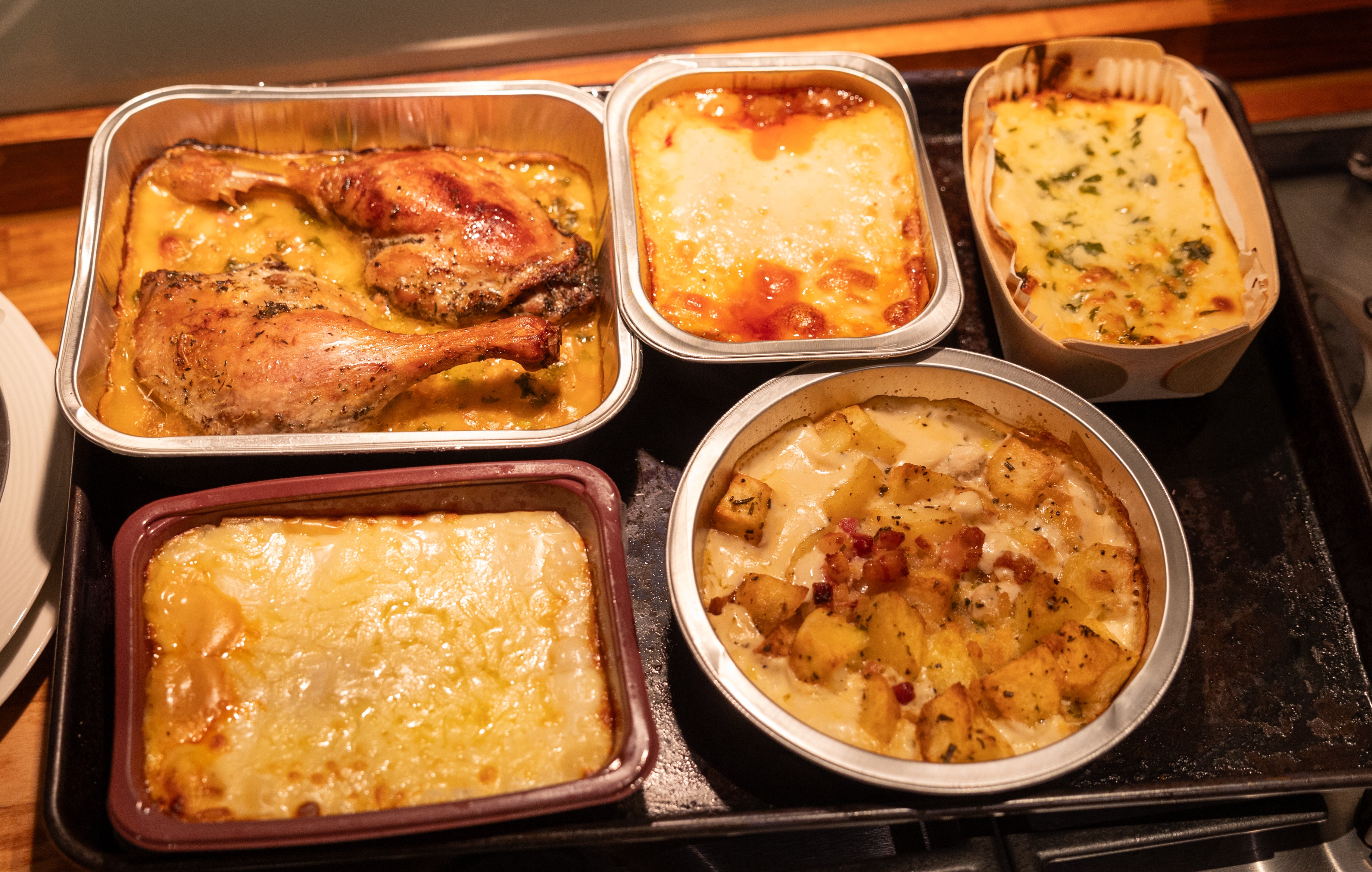The sun is setting outside the window and I am flitting round the kitchen like an unsettling hybrid of Nigella Lawson and Kerry Katona. The champagne’s in the fridge, the red’s on the table and five friends are on their way to eat. Usually I’d be frantically chopping onions at this point, but instead I’m looking round for something to do because, next to the oven, lined up in regiments, are boxes and boxes of posh ready meals.
This, if the data is to be believed, is the new middle-class dream. No longer are ready meals a shameful secret to be scoffed down in front of the television. Instead, they are something to boast about.
As cost of living pressures increase, we are changing the way we eat. Half of us are ordering fewer takeaways and 56 per cent are eating out less, according to the market research firm Mintel. Meanwhile, the value of the UK ready meals market is expected to hit £5 billion this year, driven by a rise in luxury brands such as Cook and Charlie Bigham’s. The latter’s new range of high-end meals, including a beef wellington, went on sale in Waitrose last week.

Ivers consults the small print
JOSHUA BRATT FOR THE SUNDAY TIMES
These “dine-in” meals (don’t say “ready meals”, darling, it’s terribly common) are not cheap. Charlie Bigham’s beef wellington for two — which “looked and smells like a steak bake”, according to The Times’s deputy food editor — costs £29.95. A Cook beef wellington for six will set you back £90.
But with the cost of a dinner even at a casual chain like Wagamama or Nando’s frequently hitting £50 for two, for many these dine-at-home options are starting to look more appealing. Plus, you can splash out on a nicer bottle of wine without the pain of the restaurant mark-up.
Supermarkets are also getting in on the act. Waitrose and M&S both offer their own multi-course prepared meals targeted towards couples on a date night. “This is not just a dine-in,” croons the voiceover in an advert from earlier this year. “This is an M&S Valentine’s dine-in.” Gosh.

Some of the dishes on the table at Ivers’s dinner party
JOSHUA BRATT FOR THE SUNDAY TIMES
What’s driving the trend? Economists have long speculated about the “lipstick effect”: the hypothesis that, as the economy stagnates, women who can no longer afford to regularly buy a new dress or an expensive necklace will instead spend their money on smaller luxuries, such as lipstick.
Airlines have also decided there is a market for this type of marginal luxury, with some offering customers the opportunity to pay small amounts for extra legroom or a seat without a neighbour.
Posh ready meals seem to offer a similar dose of austerity-friendly luxury. They are an expense, yes, but a small one that makes life just a little better. It is telling that budget ready meals are not seeing any particular rise in popularity, but the premium sector of the market has grown by 15 to 20 per cent over the past two years.
Are these meals actually any good? In a quest to find out, I’m throwing a dinner party: starter, main, dessert, all purchased boxed up from the fridges and freezers of my local supermarkets.
The results are mixed. Everyone falls delightedly on the creamy Aldi chicken and pancetta with potatoes, which I picked up for just £3.45 from its Specially Selected Gastro premium range. We all agree that we’d just about tolerate the Cook parmesan chicken (£7) on an aeroplane.

The Cook parmesan chicken was deemed “tolerable on an airplane”
JOSHUA BRATT FOR THE SUNDAY TIMES
But the M&S roasted duck legs “served atop a sumptuous cassoulet” (their words, I would like to stress, not mine) are causing consternation.
“I don’t think I’ve ever eaten a meat that has fought back before,” wails a friend as he picks through gristle; £12.50, since you ask.
The packaging for the victorious Aldi chicken is strewn with unnerving red health indicators. Fat: 47 per cent of your daily intake. Salt: 48 per cent. Perhaps that’s why it tastes so delicious. But many of these dishes remain firmly in the green.
The Waitrose beef bourguignon and the Tesco Finest chicken, prawn and chorizo paella only tip over into red when it comes to salt, and both packages boast about the provenance or welfare of their ingredients.
“Let’s not pretend that ready meals of any kind will be healthier than cooking from scratch at home,” says Flo Allday, a trend and brand strategy consultant who works with several food and hospitality companies. However, luxury brands have successfully “positioned themselves as beacons of trust, quality and ingredient nutrition, offering restaurant-quality food that, if not low calorie, isn’t as full of unidentifiable ingredients as traditional lower-priced ready meals”.

JOSHUA BRATT FOR THE SUNDAY TIMES
With ready meals you also know exactly what you’re getting — and they make life easy for consumers who are tracking calories. Brands such as Myprotein, sold online and in Iceland supermarkets, serve the growing swathes of the younger population obsessed with tracking their “macros” (proteins, fats and carbohydrates). You do not get that level of certainty at restaurants, or even when cooking at home.
Allday says there is an element of “controlled — or permitted — indulgence” at play in customer decisions to choose ready meals. “In today’s food culture, the joy of eating is being squeezed from all sides by Ozempic culture and a growing awareness (and fear) of ultra-processed foods, not to mention the cost of living.”
Spontaneity when going out is getting harder too. Post-pandemic booking culture and social media hype around top restaurants mean — particularly in big cities — that it’s hard to presume you’ll be able to slide behind a last-minute table.

Ready meals, however, are always there. Even if you can’t be bothered to pop to the supermarket, you can order online the perfectly decent Cook apple and blackberry crumble I serve for dessert, and Charlie Bigham’s can now be brought to your door by Deliveroo.
Our other dessert comes from M&S Gastropub range: a £5.50 chocolate cookie dough dessert for two by celebrity chef Tom Kerridge. It comes out burnt and borderline inedible. Outrageously, everyone blames me rather than Mr Kerridge.
